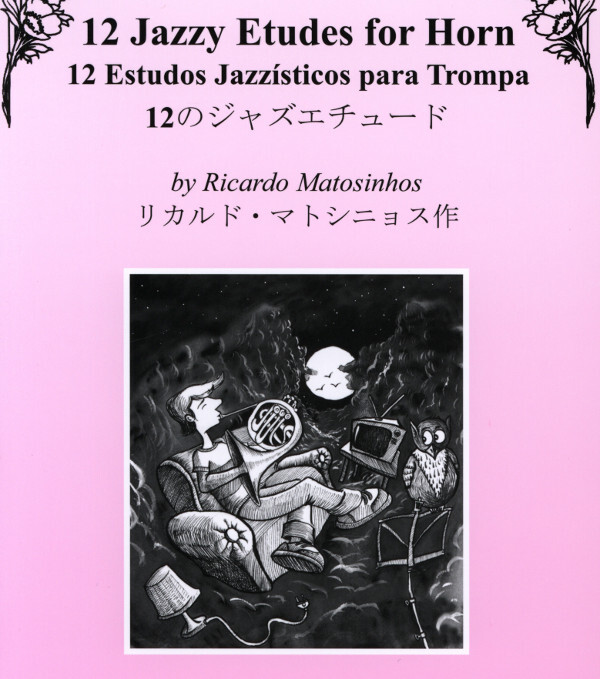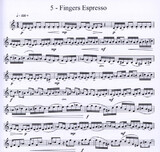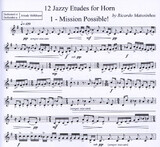 Phoenix MusicStil:
Phoenix MusicStil:  Jazz / SwingAusgabe: NotenArt-Nr.: E2366 / 921003 Level:
Jazz / SwingAusgabe: NotenArt-Nr.: E2366 / 921003 Level:
2010 komponiert
Arkady Shilkloper gewidmet
Written for the advanced student to professional, these etudes feature different techniques that are essential to horn playing. In a fun, fanciful and whimsical style, Mr Matosinhos focuses each etude on a different technique, always within a style heavily invluenced by Jazz. 24 Pages. Dedicated to Arkady Shilkloper.
You can listen to Mr Matosinhos playing some of these etuds on U-Tube. Follow the links below:
12 Jazzy Etudes for Horn No. 10
12 Jazzy Etudes for Horn No. 12
These etudes were written with the aim of filling a gap in the Horn repertoire. Usually advanced etudes for horn are too difficult in many different aspects at once. In these etudes I used different scales and modes with some extended techniques, but always in an easy and funny way; if an etude is difficult or even very difficult in one aspect, it will be easy or even very easy in others. I dedicate these etudes to the Russian horn player Arkady Shilkloper and his music, whose influence will be easily identifiable in some of these etudes.
Etude nº1 This Etude is intended to work with different rhythms of valeur ajouté (added value) similar to Olivier Messiaen's writing in that, contrary to other methods, I've decided to make the rhythm difficult but make every other aspect easy. For instance, the range is about one and a half octaves (B2-F#4) and, technically speaking, if this Etude is played entirely in Bb horn, only the first 2 fingers will be used. The chosen mode is lydian dominant (4th mode of the ascended minor melodic scale).
Etude nº2 This Etude intends to juxtapose 3 rhythms that may be confusing (Bars 1, 3 and 7). In the transitions between 3/8 and 5/16 the length of 1 bar remains the same. As indicated, one should swing on 3/8 and 5/8 bars and play straight on the 5/16 bars.
The idea is to interrupt the end - the player should not move for 2 or 3 seconds leaving the listener to guess the inevitable unplayed D.
Etude nº3 - This Etude is based on the D major pentatonic scale. It should be played at the tempo q = 120 or more, since this is usually the speed barrier between single and double tongued staccato. In order to be more effective, this etude should be played in both single and double tongued staccato. If played on Bb horn the 2nd finger remains pressed down and only the 1st finger moves.
Etude nº4 The same way some medicines have a funny taste and need to be taken with orange juice, quarter tones are also difficult to digest in our occidental half tone trained ears. I've created this etude in a form of a blues with the aim of making it easier to practice this technical resource for the horn. The indicated positions are for the 7th, 11th and 13th harmonics of the double horn that are already naturally sharp/flat. Within this etude all the quarter tones between F3 and G4 will be processed. For more information about the microtonal potential of the Horn please read: Douglas Hill's Extended techniques for the horn: A practical handbook for students, performers and composers from Warner Bros. Publications, 1996 (ASIN B00072T6B0) and David Robert Whaley's The Microtonal Capability of the Horn(Illinois Univ., 1975).
Etude nº5 This etude is based on the whole tone half tone D diminished scale. It should be played as fast as possible while making sure that all notes and articulations are clearly played.
Etude nº6 The Lydian mode appears in this Etude ornamented with energetic jumps and trills that should sound like a joke.
Etude nº7 This is written in the form of a dance with variations on an F# whole tone scale. Most of the time, the Etude is played in the medium-low register of the horn. Each 8 bar phrase brings us new intervals (major 3rd, augmented 4th, augmented 5th, minor 7th, 8th and major 10th).
Etude nº8 In this Etude intervals are played that come from the equal division of one octave (minor 2nd, major 2nd, minor 3rd, major 3rd and augmented 4th). The aim is to maintain control of a good legato, despite the speed or the intervals. There is also an echo effect created by the chords in unison and octave. At the end there are also chords, but this time the lowest note should be sung while the upper note should be played. Another difficulty in this Etude is the subdivision of the quarter notes into 64th notes at the tempo q = 32.
Etude nº9 Playing stopped notes on the horn has several difficulties. As if it wasn't hard enough to play these in tune, we also need to play these in different positions and to be able to change the hand quickly. The aim of this etude is to work on only one of these difficulties: the speed of the right hand. It is based on one stopped note at different speeds. You should avoid glissandi or pitch changes between stopped and open sounds. This Etude is built on a minor pentatonic scale, if played in Bb horn, only the 1st finger is used (and the 2nd for the stopped notes).
Etude nº10 This etude is based on the Ahava Rabboh mode, the 5th mode of the harmonic minor scale (mixolydian b9 b13). Always alternating binary and ternary rhythms, it touches an Arabic sound with some extended techniques such as chords on 5th's and octaves, arpeggios with the right hand, fingernails on the tuning slides and percussive air effects.
Etude nº11 This etude is to be played in different harmonic series. The slashed indication above (in F, in Eb etc.) doesn't mean that these sections are to be transposed, they indicate tube lengths (ex: in D = F horn + 1+2). This kind of notation can be found in the 2nd movement of György Ligeti's Trio for horn, violin and piano. The microtonal signs refer to naturally sharp or flat harmonics of the relevant harmonic series.
Etude nº12 This etude is built on horn chords in two sections. In the first half it is intended to explore the tuning beats, using them as dynamic effects. In the second half the aim is to practice parallel horn chords on 5ths, 6ths, octaves and 10ths.
Ricardo Matosinhos
Estes estudos foram escritos com o intuito de preencher um espaço em branco no repertório da trompa. Geralmente os estudos avançados para trompa são demasiado difíceis em vários aspectos. Nestes estudos procurei utilizar diferentes modos e escalas com algumas técnicas e efeitos especiais, mas sempre de uma forma fácil e divertida, em que se um estudo for difícil ou mesmo muito difícil num aspecto, será fácil ou mesmo muito fácil noutros. Dedico estes estudos ao trompista russo Arkady Shilkloper e à sua música. Em alguns destes estudos será fácil identificar as influências.
Estudo nº1 - Neste estudo pretende-se que sejam trabalhados diversos ritmos de valeur ajouté (valor acrescentado) à semelhança do tipo de escrita de Olivier Messiaen. Para tal ao contrário de outros métodos, optei por dificultar o ritmo mas facilitar todos os outros aspectos: a tessitura é de cerca de uma oitava e meia (Si2-Fá#4) e tecnicamente, se este estudo for tocado integralmente em trompa Sib, apenas serão utilizados 2 dedos em todo o estudo. Relativamente ao modo escolhido, trata-se do modo lídio dominante (modo do 4º grau da escala menor melódica ascendente)
Estudo nº2 - Este estudo pretende contrapor 3 ritmos que podem gerar confusão (c.1, 3 e 7). Nas transições entre compassos 3/8 e 5/16, o tempo de 1 compasso permanece o mesmo. Tal como indicado, é pretendido swing nos compassos 3/8 e 5/8 e straight nos compassos de 5/16.
A ideia é que o final fique interrompido e que o intérprete permaneça imóvel por 2 a 3 segundos assim que terminar o estudo deixando adivinhar a nota Ré que inevitavelmente se seguiria.
Estudo nº3 - Este estudo está baseado na escala pentatónica maior de Ré. Deverá ser executado numa velocidade de semínima igual ou superior a 120 b.p.m. uma vez que esta velocidade costuma ser a fronteira entre staccato simples e duplo. Para ser mais eficaz, este estudo deverá ser tocado em staccato simples e duplo. Se tocado em trompa Sib o 2º dedo permanece imóvel e apenas o 1º dedo se movimenta.
Estudo nº4 - Da mesma forma que há alguns medicamentos com um sabor desagradável e têm que ser dissolvidos em sumo de laranja, os ¼ de tom também são de difícil digestão para os nossos ouvidos ocidentais, treinados a ½ tom. Criei este estudo sob a forma de um blues com o intuito de facilitar o estudo deste recurso técnico da trompa. As posições indicadas baseiam-se nos 7os, 11os e 13os harmónicos da trompa Fa/Sib que naturalmente já se encontram baixos/altos. Com este estudo são trabalhados todos os quartos de tom existentes entre o Fá índice 3 e Sol índice 4. Para mais informações sobre o potencial microtonal da trompa consulte: Extended techniques for the horn: A practical handbook for students, performers and composers de Douglas Hill, Warner Bros. Publications, 1996 (ASIN B00072T6B0) e The Microtonal Capability of the Horn Tese de doutoramento de David Robert Whaley (Univ. Illinois, 1975)
Estudo nº5 - Este estudo é baseado na escala diminuta (tom-½ tom) começando em Ré. Deverá ser tocado o mais rápido possível mas de forma a que todas as notas e articulação sejam claramente perceptíveis.
Estudo nº6 O modo lídio aparece neste estudo ornamentado com vários trilos enérgicos e saltos que deverão ter um carácter de brincadeira.
Estudo nº7 - Trata-se de uma dança com variações sobre uma escala de tons inteiros começando em Fá#. Predominantemente o estudo encontra-se no registo médio-grave da trompa. Cada frase tem oito compassos e inaugura novos ritmos ou intervalos (3ª Maior, 4ª Aumentada, 5ª Aumentada, 7ª menor, 8ª e 10ª Maior).
Estudo nº8 - Neste estudo são abordados intervalos derivados da divisão igual de uma oitava (2ª menor, 2ª maior, 3ª menor, 3ª maior e quarta aumentada). O objectivo é controlar um bom legato, independentemente da velocidade ou do intervalo. Existe igualmente neste estudo um efeito de eco causado pelos sons multifónicos em uníssono e oitava. No final do estudo, aparecem novamente multifónicos, sendo que desta vez é a voz inferior que é cantada. Uma outra dificuldade é a subdivisão, q = 32 a qual se tem que subdividir em outros valores que chegam a 16 semifusas.
Estudo nº9 - Tocar sons fechados na trompa apresenta diversas dificuldades. Como se não bastasse ser difícil afinar, é ainda preciso tocar com uma posição diferente e com maior velocidade de ar. Com este estudo, pretende trabalhar-se apenas uma das dificuldades: o movimento rápido da mão direita. Baseia-se essencialmente numa nota fechada a diferentes velocidades, devendo evitar-se glissandi ou mudanças de afinação entre sons fechados e sons abertos. O estudo está construído sob uma escala pentatónica menor, se tocado em trompa Sib apenas é utilizado o 1º dedo. (2º para bouchés)
Estudo nº10 - Este estudo é baseado no modo Ahava Rabboh. É um modo construído sobre o 5º grau da escala menor harmónica (Mixolídio b9 b13). Consiste na alternância constante entre métrica binária e ternária. Com uma sonoridade com um quê de árabe, tem ainda alguns efeitos como sons multifónicos à 5ª e 8va, arpegiato com as unhas da mão direita sobre as bombas de afinação e efeitos percussivos com o ar.
Estudo nº11 - Este estudo está concebido para ser executado em diferentes séries de harmónicos. As indicações a tracejado (in F, in Eb etc.) não indicam transposições, mas sim de comprimentos de tubo (ex: in D = Trompa Fá +1+2). Este tipo de indicações pode ser encontrado nas obras de György Ligeti, como é o caso do 2º andamento do Trio para violino, trompa e piano, o Concerto para trompa (Hamburgo) ou o concerto para Piano. Quanto às indicações micro-tonais, referem-se a harmónicos naturalmente baixos ou altos, consoante a série em que se encontram.
Estudo nº12 - Este estudo está construído em sons multifónicos com duas secções. Na primeira pretende explorar-se os batimentos destes e utiliza-los como efeitos de dinâmica. Já na segunda parte o objectivo é o estudo paralelo de multifónicos em intervalos de quinta, sexta, oitava e décima.
Ricardo Matosinhos
Horn playing has nothing to do with good or bad luck,
it is all about practicing!
by Ricardo Matosinhos







